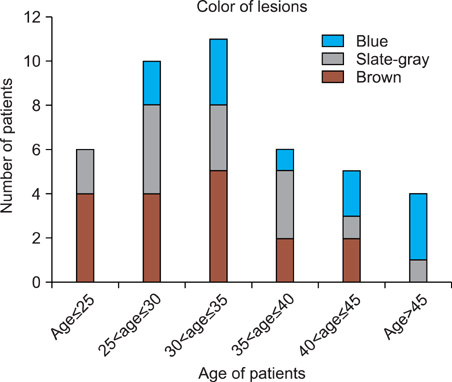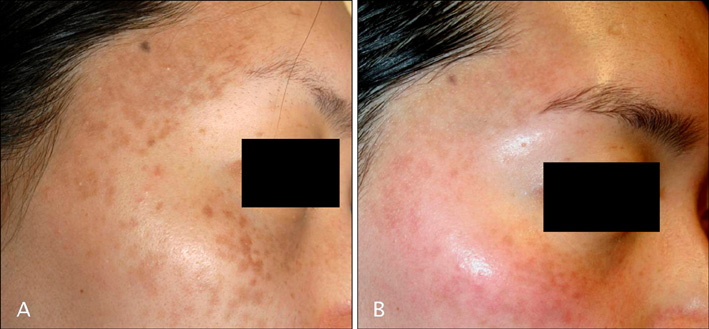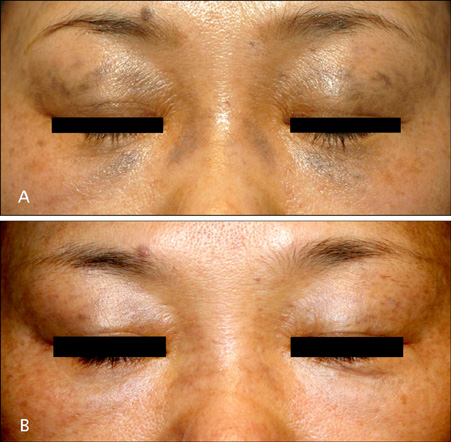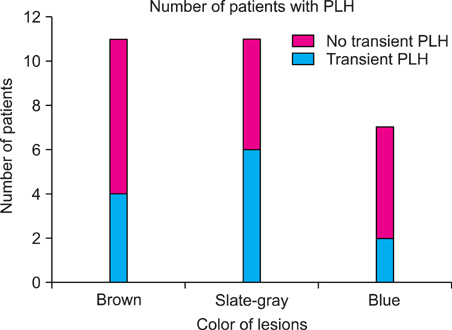Ann Dermatol.
2009 Aug;21(3):255-260. 10.5021/ad.2009.21.3.255.
Q-Switched Nd:YAG Laser Therapy of Acquired Bilateral Nevus of Ota-like Macules
- Affiliations
-
- 1Department of Dermatology, Asan Medical Center, University of Ulsan College of Medicine, Seoul, Korea. cse@amc.seoul.kr
- KMID: 2266286
- DOI: http://doi.org/10.5021/ad.2009.21.3.255
Abstract
-
BACKGROUND: Acquired bilateral nevus of Ota-like macules (ABNOM) is a dermal pigmented lesion common in individuals of Oriental origin. The Q-switched Nd:YAG laser (QSNYL) has been used successfully to treat a variety of benign, dermal, pigmented lesions, including nevus of Ota lesions. The similarity between ABNOM and nevus of Ota suggested that QSNYL may also be effective in the former.
OBJECTIVE
To determine the efficacy and side-effect profiles of QSNYL treatment of ABNOM in Korean patients.
METHODS
Of 42 Korean patients with ABNOM, 29 were treated with QSNYL (1,064 nm, 3 mm spot size, fluence 8~9.5 J/cm2), for up to 10 sessions each. Clinical photographs were taken before and after treatment. Lesion clearance was graded and complications such as hyperpigmentation, scarring, hypopigmentation, and erythema were assessed.
RESULTS
Of the 29 treated patients, 19 (66%) showed excellent or good results. Of the patients who were treated more than 3 times, 76% showed good to excellent results. Two patients experienced post-laser hyperpigmentation (PLH), which persisted for more than one month, but no patient experienced persistent erythema or hypertrophic scarring.
CONCLUSION
QSNYL is safe and effective in the treatment of ABNOM in Korean patients. Short-interval repetitive treatment is especially useful in improving therapeutic results and reducing PLH.
MeSH Terms
Figure
Cited by 1 articles
-
Beneficial Effect of Low Fluence 1,064 nm Q-Switched Neodymium:Yttrium-Aluminum-Garnet Laser in the Treatment of Senile Lentigo
Jae-Hui Nam, Han-Saem Kim, Ga-Young Lee, Won-Serk Kim
Ann Dermatol. 2017;29(4):427-432. doi: 10.5021/ad.2017.29.4.427.
Reference
-
1. Hori Y, Kawashima M, Oohara K, Kukita A. Acquired, bilateral nevus of Ota-like macules. J Am Acad Dermatol. 1984. 10:961–964.
Article2. Hori Y, Takayama O. Circumscribed dermal melanoses. Classification and histologic features. Dermatol Clin. 1988. 6:315–326.
Article3. Kunachak S, Kunachakr S, Sirikulchayanonta V, Leelaudomniti P. Dermabrasion is an effective treatment for acquired bilateral nevus of Ota-like macules. Dermatol Surg. 1996. 22:559–562.
Article4. Goldberg DJ, Nychay SG. Q-switched ruby laser treatment of nevus of Ota. J Dermatol Surg Oncol. 1992. 18:817–821.5. Geronemus RG. Q-switched ruby laser therapy of nevus of Ota. Arch Dermatol. 1992. 128:1618–1622.
Article6. Alster TS, Williams CM. Treatment of nevus of Ota by the Q-switched alexandrite laser. Dermatol Surg. 1995. 21:592–596.
Article7. Chan HH, Ying SY, Ho WS, Kono T, King WW. An in vivo trial comparing the clinical efficacy and complications of Q-switched 755 nm alexandrite and Q-switched 1064 nm Nd:YAG lasers in the treatment of nevus of Ota. Dermatol Surg. 2000. 26:919–922.
Article8. Ee HL, Wong HC, Goh CL, Ang P. Characteristics of Hori naevus: a prospective analysis. Br J Dermatol. 2006. 154:50–53.
Article9. Suh DH, Han KH, Chung JH. Clinical use of the Q-switched Nd:YAG laser for the treatment of acquired bilateral nevus of Ota-like macules (ABNOMs) in Koreans. J Dermatolog Treat. 2001. 12:163–166.
Article10. Kunachak S, Leelaudomlipi P. Q-switched Nd:YAG laser treatment for acquired bilateral nevus of ota-like maculae: a long-term follow-up. Lasers Surg Med. 2000. 26:376–379.
Article11. Polnikorn N, Tanrattanakorn S, Goldberg DJ. Treatment of Hori's nevus with the Q-switched Nd:YAG laser. Dermatol Surg. 2000. 26:477–480.
Article12. Manuskiatti W, Fitzpatrick RE, Goldman MP. Treatment of facial skin using combinations of CO2, Q-switched alexandrite, flashlamp-pumped pulsed dye, and Er:YAG lasers in the same treatment session. Dermatol Surg. 2000. 26:114–120.
Article13. Lee B, Kim YC, Kang WH, Lee ES. Comparison of characteristics of acquired bilateral nevus of Ota-like macules and nevus of Ota according to therapeutic outcome. J Korean Med Sci. 2004. 19:554–559.
Article14. Ee HL, Goh CL, Khoo LS, Chan ES, Ang P. Treatment of acquired bilateral nevus of ota-like macules (Hori's nevus) with a combination of the 532 nm Q-Switched Nd:YAG laser followed by the 1064 nm Q-switched Nd:YAG is more effective: prospective study. Dermatol Surg. 2006. 32:34–40.
Article15. Lam AY, Wong DS, Lam LK, Ho WS, Chan HH. A retrospective study on the efficacy and complications of Q-switched alexandrite laser in the treatment of acquired bilateral nevus of Ota-like macules. Dermatol Surg. 2001. 27:937–941.
Article16. Momosawa A, Yoshimura K, Uchida G, Sato K, Aiba E, Matsumoto D, et al. Combined therapy using Q-switched ruby laser and bleaching treatment with tretinoin and hydroquinone for acquired dermal melanocytosis. Dermatol Surg. 2003. 29:1001–1007.
Article17. Manuskiatti W, Sivayathorn A, Leelaudomlipi P, Fitzpatrick RE. Treatment of acquired bilateral nevus of Ota-like macules (Hori's nevus) using a combination of scanned carbon dioxide laser followed by Q-switched ruby laser. J Am Acad Dermatol. 2003. 48:584–591.
Article
- Full Text Links
- Actions
-
Cited
- CITED
-
- Close
- Share
- Similar articles
-
- A Case of Acquired Bilateral Nevus of Ota-like Macules Accompanying the Common Blue Nevus
- Tree Cases of Aquired bilateral Nevus of Ota-like Marcules
- Comparison of Characteristics of Acquired Bilateral Nevus of Ota-like Macules and Nevus of Ota According to Therapeutic Outcome
- A Case of Acquired Bilateral Nevus of Ota-like Macules
- Acquired, Bilateral Nevus of Ota-like Macules (ABNOM) Associated with Ota's Nevus: Case Report






